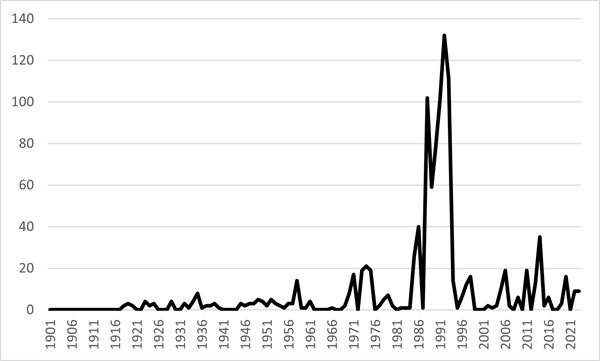The second House of Representatives (HoR) debating venue, the Federation Chamber, is unique among Australian Parliaments. 30 years ago amendments to the Standing Orders (SOs) were made on 10 February 1994, to establish a second chamber to function in parallel to the HoR. After an existing committee room in Parliament House was refurbished at a cost of $854,902 (p. 51), the inaugural meeting of the second chamber was held 4 months later on 8 June 1994. It was on that occasion, John Howard remarked:
If the Main Committee can add to the intelligent dispatch of business and, in this rather more intimate atmosphere, lift the quality of debate on some of the less contentious but nonetheless detailed pieces of legislation, the whole parliamentary system and the community will be the beneficiaries.
Initially called the ‘Main Committee’, it became the ‘Federation Chamber’ in 2012 to avoid confusion with the ‘main committee room’.
More opportunities for legislative debate?
The Federation Chamber was originally intended to relieve time pressure in considering legislation. Members (MPs) were concerned with the marked increase of their legislative workload and the frequency with which Government was using procedural methods, such as the ‘guillotine’, to shut down debate (p. 4). In theory, a second chamber would allow MPs greater time and opportunity to debate Bills without increasing the number or length of sitting days and avoid the need to ‘guillotine’ debate.
The Federation Chamber’s establishment (and associated changes to standard sitting hours) had immediate effects. Sittings after midnight became rare and ‘guillotine’ use declined significantly—from ‘a record high of 132 Bills guillotined in 1993 to only 14 in 1994’ (p. 9).
Chart 1: Number of Bills ‘guillotined’ or considered under a time limitation in the House of Representatives per year, 1901–2023

Source: HoR Work of the Session and Practice, ‘Appendix 20—Statistics on selected House proceedings’.
Note: From 2005 includes Bills ‘guillotined’ and Bills considered under a time limitation.
However, other procedures to accelerate a Bill’s passage or curtail debate, such as closure motions, have continued. As HoR Practice notes, the ‘guillotine’ procedure ‘has been largely superseded by debate management motions, which in effect impose a guillotine by other means’.
Chart 2: Number of closure motions agreed to in the House of Representatives per year, 1901–2023

Source: HoR Work of the Session and Practice, ‘Appendix 20—Statistics on selected House proceedings’.
Note: Includes closure of question and closure of Member motions.
The Federation Chamber has also become used for a wider range of business than originally intended (p. 11–12). Though it was always designed for debate on less controversial matters, emphasis was originally placed on legislative debates, namely second reading and consideration-in-detail stages of Bills (p. 12), rather than discussion of committee reports and constituency matters as it became (p. 9).
No more than half of the introduced legislation each year has been considered in the Federation Chamber (a high of 46% was reached in 1997). The 44th and 46th Parliaments had the lowest number of Bills referred to the Federation Chamber, however the current Parliament has substantially reversed this trend.
Chart 3: Percentage of Bills introduced in the House of Representatives that were referred to the Federation Chamber per Parliament, 1994–2023

Source: Parliamentary Library calculations based on HoR Statistical Digest.
*Figures for the 37th Parliament are from the start of 1994; figures for the 47th Parliament are to the end of 2023.
Note: Only includes Bills introduced in the HoR and Bills received from Senate.
(Dis)order in the Federation Chamber
As divisions are not permitted, the Federation Chamber relies solely on co-operation to function. Any disagreements on the Chair’s ruling need to be resolved in the House of Representatives chamber. On rare occasions of Members’ disorderly conduct, the Chair’s only option is to eject an unruly Member for 15 minutes (under SO 187b) or suspend the sitting. For instance, in the last Parliament the Federation Chamber meeting was suspended on two separate occasions (27 February 2020 and 4 December 2019) after ALP and Coalition MPs repeatedly moved closure motions against one another.
To avoid hostile behaviour, generally the most non-controversial legislation is referred for debate. As Kim Beazley stated during the establishment of the second chamber:
If the main committee is to work as envisaged by the Blewett committee and by the government, it ought to have before it legislation which is effectively non-controversial but which does require a bit of detailed attention from the House, in the spirit of bipartisan cooperation.
…
It is also intended that this informal mode of operation should not extend to ready tolerance of disorder. The standing orders are devised in such a way that any of the people in the main committee, but particularly the Presiding Officer, can shut the main committee down and take the matter back to the chamber for that disorder to be resolved. Hopefully, that is not a situation which will ever be required.
International comparisons
The Australian Parliament’s Federation Chamber was a useful frame of reference for the UK Parliament to establish a similar structure in 1999, referred to as ‘Westminster Hall’. In proposing the UK model, the select committee on Modernisation of House of Commons specifically examined the Federation Chamber’s function in providing more opportunities for parliamentary debate (p. 9). Both the Australian and UK second chambers are open to all MPs; require a quorum of only 3 MPs; can only meet when the main chamber is sitting; and need co-operation to function in practice.
However, unlike the Federation Chamber which can hold debates on virtually any parliamentary business, Westminster Hall is only used for debates on topics proposed by backbenchers and the Backbench Business Committee; select committee reports; and e-petitions (p. 5).
Additionally, other national parliaments such as Canada and Kenya have considered parallel debating chambers in order to provide more opportunities for parliamentary debate.